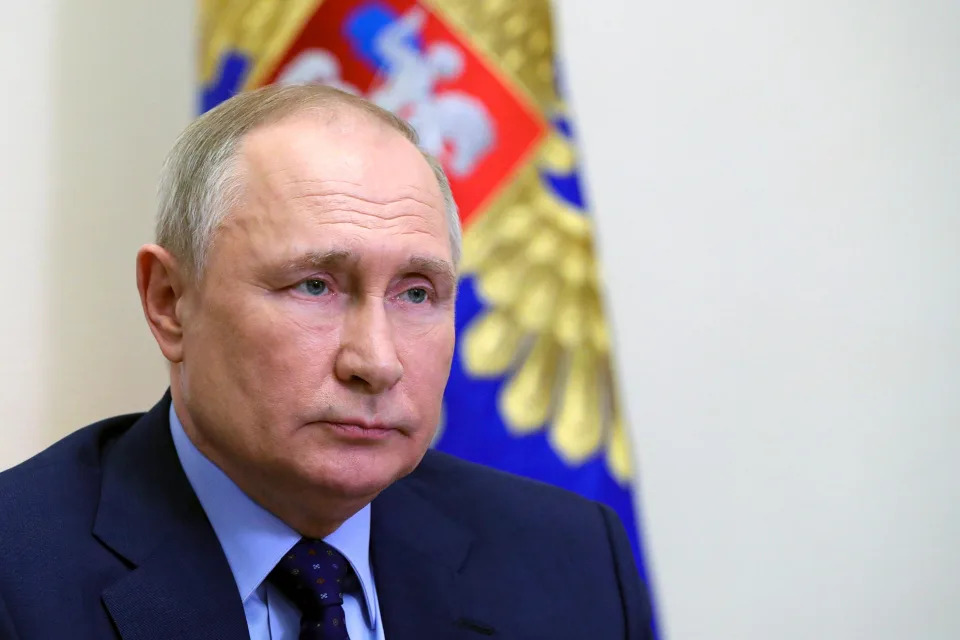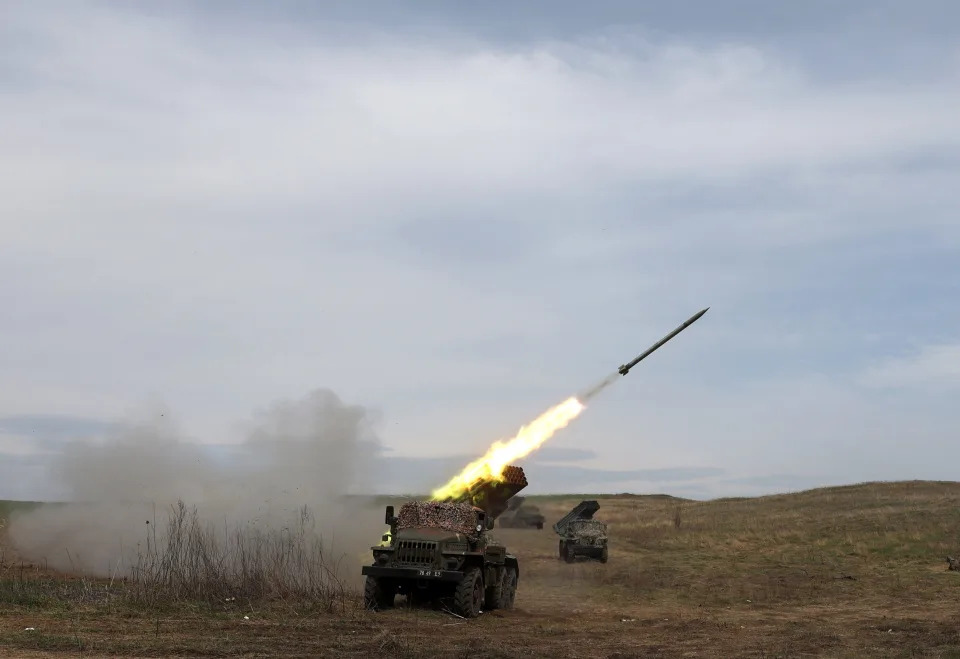USA Today
Does Vladimir Putin have an endgame in Ukraine? The next few weeks are crucial.
Maureen Groppe and Tom Vanden Brook, USA Today – May 4, 2022
As the United States and its allies rush more cannons, tanks and ammunition to Ukraine, Russia’s diminished military is looking for victories to justify the huge cost of President Vladimir Putin’s invasion.
Putin hopes to gain in eastern Ukraine and parts of the Black Sea coastline. If successful, he could claim he met an initial objective of securing the Donbas area contested by Ukrainians and Russian-backed separatists since 2014.
If Russia exhausts Ukrainian defenses there, Putin might force Ukrainian President Volodymyr Zelenskyy to the negotiating table, giving Russia time to rebuild its military for a renewed push on the rest of the country.
Through $1.6 billion in military aid announced last month and visits to Ukraine last week by Secretary of State Antony Blinken and Defense Secretary Lloyd Austin, the United States is trying to help block that option.
Calling the next few weeks pivotal, a senior Defense Department official said Russia will “have some real decisions to make” if its new offensive doesn’t succeed.
What happens in the next month, said the official, who spoke on the condition of anonymity, could determine security conditions in Europe for a generation.
Even if Putin continues to be thwarted in his attempt to take over Ukraine, the war could settle into a long-term, low-level conflict as Russian troops remain in parts of the country. Their presence would be a destabilizing force as Russia prepares for a new opportunity.
That’s something the United States hopes to head off.
“We want to see Russia weakened to the degree that it can’t do the kinds of things that it has done in invading Ukraine,” Austin said last week when asked how he would define success in Ukraine.
President Joe Biden asked Congress on Thursday to approve an additional $33 billion in military, economic, humanitarian and other assistance to Ukraine. That would more than triple the amount the United States has committed to the cause.
The funding is intended to meet the needs of the Ukrainian military “during the crucial weeks and months ahead,” Biden said, as well as begin a transition to longer-term security assistance to help Ukraine deter and defend against Russian aggression.
Watch: US Secretary of Defense Lloyd Austin says Ukraine can win war with Russia
Tracking the invasion: See where Russian forces are moving

Could Putin turn Ukraine into another ‘frozen conflict’?
Dmitri Alperovitch, the Russian-born American chairman of Silverado Policy Accelerator, a public policy nonprofit, said the focus in Ukraine’s south and east is the last major offensive Russia’s military can undertake for a while.
This phase of the war, Alperovitch said in an online salon organized by the Defense Priorities think tank, is likely to end “one way or another” in the next four to five weeks.
If Russia’s military can enlarge its holdings in Donbas and connect the area to Crimea, creating a strategic corridor between the Crimean Peninsula and Russian positions in eastern Ukraine, that could allow Putin to claim a victory he can sell to the Russian public, said Charles Kupchan, a senior fellow at the Council on Foreign Relations and professor of international affairs at Georgetown University.
“The death and destruction that’s taken place in Ukraine, the atrocities, the dislocation of millions of families, all of this makes it less and less likely that this war will end with a formal settlement,” he said. “It’s hard for me to imagine that Zelenskyy’s room for a political maneuver and Putin’s room for political maneuver overlap.”
“It simply does not exist anymore”: The devastation of Mariupol
US military aid to Ukraine: Breaking down the more than $3 billion assistance

The result might be a years-long territorial dispute with low-level military conflict, as has happened in other areas of interest to Russia.
“Historically speaking, these wars in the Russian periphery end with frozen conflicts,” Kupchan said. “Russian troops have a tendency to show up and not go home.”
After fighting a war with Georgia in 2008, Russia recognized the breakaway regions of South Ossetia and Abkhazia as independent. It maintains a military presence there and provides financial support.
Similarly, Russian troops have been stationed for decades as “peacekeepers” in Transnistria, a pro-Russia breakaway region of Moldova.
Learn more: Transnistria, a sliver of land between Moldova and Ukraine, is becoming a focus of war
Putin uses frozen conflicts in former Soviet republics to upset their development and prevent them from aligning with the West, according to experts.
Before Russia invaded Ukraine in February – aiming to topple the capital of Kyiv – Russian and proxy forces held about 35% of the territory in the Donetsk and Luhansk areas of Donbas, according to Steven Pifer, a former U.S. ambassador to Ukraine and a William Perry Fellow at Stanford University.
Taking over all of Donbas might be Putin’s new endgame, Pifer said, but Russia’s ability to do so is debatable.
“There’s still a significant portion of the Ukrainian military in that territory,” he said.
Russian sanctions: While Putin’s Russian family was targeted, a larger shadow family may remain
A port city, a steel cage, a palace: The steps that made Putin ‘the richest man in the world’

‘You can’t reform an army in a matter of a couple of weeks’
The Washington-based Institute for the Study of War said in an analysis April 18 that Russian forces may gain ground in the east through the heavy concentration of firepower and the size of their forces. Russia is unlikely to be dramatically more successful than major offensives around Kyiv, according to the analysis, because the military probably hasn’t fixed its underlying problems – poor coordination, the inability to conduct cross-country operations and low morale.
“You can’t reform an army in a matter of a couple of weeks,” retired Army Lt. Gen. Douglas Lute, a former U.S. ambassador to NATO, said last week on ABC’s “This Week With George Stephanopoulos.”
The United States increased its military assistance to include the type of weapons needed to fight back in eastern Ukraine, where artillery and armored vehicles are likely to play a central role.
The Ukrainians’ greatest need is for long-range guns and rockets that can reach deep into Russian lines. The terrain in eastern Ukraine is more open than that of the north where forests helped defenders ambush and thrash Russian convoys.
“The open flatlands provide some advantage to the Russian army,” said Garret Martin, an expert on trans-Atlantic relations at American University, “but it exposes them as well.”
The increased stakes are part of what’s driving the urgent mission to supply the Ukrainian army with long-range artillery weapons, according to a senior Defense Department official.
Biden announced on April 21 an $800 million military aid package that includes 72 howitzer artillery cannons. That came days after a separate $800 million batch of weapons included 18 howitzers.
With 90 cannons, the Ukrainian army can outfit about five artillery battalions.
U.S. troops have begun training Ukrainians on how to fire them, a process that takes about a week, according to a second senior defense official who spoke on condition of anonymity.
From Potemkin to Putin: What a centuries-old myth reveals about Russia’s war against Ukraine
Opinion: As Mariupol is destroyed, NATO must make it clear to Putin that he will not win.

The howitzers have a range of about 15 miles or longer, depending on the type of shell they fire. The aid package included 144,000 rounds of artillery ammunition.
By extending the amount of training for Ukrainians, the administration signals that the war may go on for weeks or months, according to an assessment by Mark Cancian, a senior adviser with the International Security Program at the Center for Strategic and International Studies.
The Russians have a great deal of combat power inside Ukraine despite losing about 25% of those forces since the invasion began Feb. 24, according to the Pentagon.
Is Putin interested in an off-ramp to the war in Ukraine?
The Russian military learned from its mistakes around Kyiv and appears to have focused on supplying its troops in the east with the fuel and ammunition they need to fight, according to a senior defense official.
As both sides refocused their firepower, U.N. Secretary-General Antonio Guterres met last month with Putin in Moscow and Zelenskyy in Kyiv. While Guterres was in Ukraine Thursday, a Russian missile struck Kyiv, an attack Zelenskyy said was an attempt to “humiliate” the United Nations.
Putin doesn’t appear to be looking for a way out of the conflict despite his major miscalculation on how events would unfold, experts said.
“I don’t see an off-ramp. I don’t think Putin is interested in an off-ramp,” said Angela Stent, a senior adviser to the Center for Eurasian, Russian and East European Studies and author of “Putin’s World: Russia Against the West and With the Rest.”
Rather than a way out, Putin is “desperately looking for a big victory so Russia can dictate the terms of the negotiations,” said Zia Haque, director of the Baker Institute for Peace and Conflict Studies and assistant professor of peace and conflict studies at Juniata College.
“Putin feels like this is going to be his survival,” Haque said. “He strongly feels that he cannot lose the war. He cannot afford to lose it.”
Ukrainian Prime Minister Denys Shmyhal said last week that the only way to end the war is a full withdrawal of Russian troops.
“I think that this war should be finished,” Shmyhal said on CBS’ “Face the Nation,” “when we clean our territories from Russian occupants.”
Contributing: Kim Hjelmgaard
